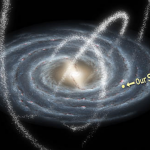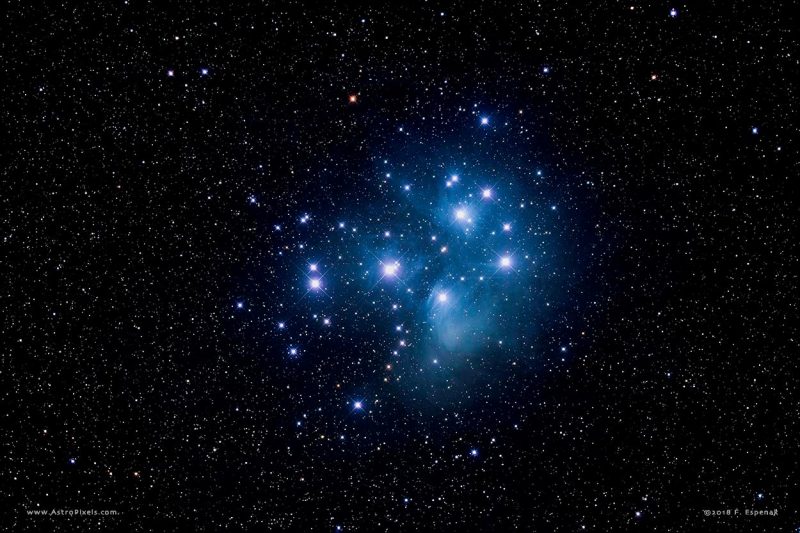

Illustration depicting star streams in the Milky Way (not the Theia streams) via NASA/ Northwestern University.
Astronomers have identified many more or less spherical clumps of stars born together and still traveling together through space. We call them open star clusters; many are well known as beautiful places in the sky to see through binoculars or a small telescope. On January 15, 2021, at a virtual session during this week’s meeting of the American Astronomical Society, astronomers presented new research on a different sort of collection of sibling stars. Theia 456 isn’t an open cluster. It’s what’s called a stellar stream, a group of stars stretched out linearly, in this case over some 500 light-years. The astronomers studying Theia 456 combined multiple datasets including those captured by ESA’s Gaia satellite, which is carefully tracking the positions (and hence movements) of over a billion stars over a five-year period. They found that – despite its stretched-out shape – all of Theia 456’s 468 stars are indeed siblings, born at the same time and traveling in the same direction across the sky.
That means our understanding of how sibling stars can exist with one another, within the confines of our Milky Way galaxy, is evolving.
Jeff Andrews of Northwestern University is a member of the research team and the presenter of the new information about Theia 456 at the AAS meeting this week. He said in a statement:
Most stellar clusters are formed together. What’s exciting about Theia 456 is that it’s not a small clump of stars together. It’s long and stretched out. There are relatively few streams that are nearby, young and so widely dispersed.

Here’s an ordinary open star cluster, what we typically think of when speaking of sibling stars. This cluster is called the Pleiades. Its stars were born from a single cloud of gas; you can see here that they’re still surrounded by a veil of nebulosity. Gazing at the sky with just your eye, you could glimpse the distinct dipper-like shape of the Pleiades easily. Stars streams can’t be “seen” in that same sense. They’re found by mining data from spacecraft, like Gaia. Astronomer Fred Espenak captured this photo in 2018. Read more about open star clusters, like the Pleiades.
Researchers believe long strings of stars started out as tight open clusters. They believe these particular clusters were gradually ripped apart and stretched out into long streams by tidal forces within the Milky Way. Andrews said:
As we’ve started to become more advanced in our instrumentation, our technology and our ability to mine data, we’ve found that stars exist in more structures than clumps. They often form these streams across the sky. Although we’ve known about these for decades, we’re starting to find hidden ones.
In other words, until recently, most known stellar streams didn’t consist of young, sibling stars orbiting in the flat disk or plane of our Milky Way galaxy. A look at a short list of known stellar streams in the Milky Way on Wikipedia, for example, shows their origins as globular star clusters (old, symmetrical clusters found in our galaxy’s halo) or dwarf galaxies orbiting outside the Milky Way’s flat plane. These sorts of stellar streams were discovered by telescopes pointed above or below the Milky Way’s plane.
Theia 456 does dwell within the Milky Way’s flat plane or disk. These astronomers referred to it as “hidden” because it’s easily lost within the galaxy’s backdrop of 400 billion disk stars. Andrews commented:
We tend to focus our telescopes in other directions because it’s easier to find things. Now we’re starting to find these streams in the [disk of the] galaxy itself. It’s like finding a needle in a haystack. Or, in this case, finding a ripple in an ocean.
Theia 456 isn’t the only one of its kind, although it may be the only one so far that’s been studied so extensively. In fact, these astronomers said:
The Milky Way houses 8,292 recently discovered stellar streams – all named Theia.

Here’s a schematic of our Milky Way galaxy. Most known stellar streams lie outside the galaxy’s flat disk. Theia 456 lies within the disk of the galaxy. Image via Cosmos.
These astronomers’ statement explained:
Identifying and examining these structures is a data science challenge. Artificial intelligence algorithms combed huge datasets of stellar data in order to find these structures. Then Andrews developed algorithms to cross-reference those data with preexisting catalogs of documented stars’ iron abundances.
Andrews and his team found that the 500 stars within Theia 456 had similar iron abundances, which means that – 100 million years ago – the stars likely formed together.
They also found that the stars in Theia 456 are moving together in the same direction. Andrews said:
If you know how the stars are moving, then you can backtrack to find where the stars came from. As we rolled the clock backwards, the stars became closer and closer together. So, we think all these stars were born together and have a common origin.
In addition to date from the Gaia satellite, these astronomers used data from NASA’s Transiting Exoplanet Survey Satellite (TESS) and from the Zwicky Transient Facility. Andrews said that combining datasets and data mining is essential to understanding the universe around us:
You can only get so far with one dataset. When you combine datasets, you get a much richer sense of what’s out there in the sky.

Astrophysicist Jeff Andrews of Northwestern University.
Bottom line: Resaarchers have discovered that Theia 456 – a stellar stream, or linear collection of stars moving together through space – contains 468 stars born at the same time. This tells us that stars born together can move together in clumps (open star clusters) or in streams like Theia 456.
Source: “Theia 456: A New Stellar Association in the Galactic Disk,” presented as part of a session on the modern Milky Way at the 237th meeting of the American Astronomical Society.
Read more about Gaia’s 2nd data release: 1.7 billion stars!
Read more about Gaia’s 3rd data release: Gazing toward the galactic anticenter
Via Northwestern
from EarthSky https://ift.tt/2LyNOYM


Illustration depicting star streams in the Milky Way (not the Theia streams) via NASA/ Northwestern University.
Astronomers have identified many more or less spherical clumps of stars born together and still traveling together through space. We call them open star clusters; many are well known as beautiful places in the sky to see through binoculars or a small telescope. On January 15, 2021, at a virtual session during this week’s meeting of the American Astronomical Society, astronomers presented new research on a different sort of collection of sibling stars. Theia 456 isn’t an open cluster. It’s what’s called a stellar stream, a group of stars stretched out linearly, in this case over some 500 light-years. The astronomers studying Theia 456 combined multiple datasets including those captured by ESA’s Gaia satellite, which is carefully tracking the positions (and hence movements) of over a billion stars over a five-year period. They found that – despite its stretched-out shape – all of Theia 456’s 468 stars are indeed siblings, born at the same time and traveling in the same direction across the sky.
That means our understanding of how sibling stars can exist with one another, within the confines of our Milky Way galaxy, is evolving.
Jeff Andrews of Northwestern University is a member of the research team and the presenter of the new information about Theia 456 at the AAS meeting this week. He said in a statement:
Most stellar clusters are formed together. What’s exciting about Theia 456 is that it’s not a small clump of stars together. It’s long and stretched out. There are relatively few streams that are nearby, young and so widely dispersed.

Here’s an ordinary open star cluster, what we typically think of when speaking of sibling stars. This cluster is called the Pleiades. Its stars were born from a single cloud of gas; you can see here that they’re still surrounded by a veil of nebulosity. Gazing at the sky with just your eye, you could glimpse the distinct dipper-like shape of the Pleiades easily. Stars streams can’t be “seen” in that same sense. They’re found by mining data from spacecraft, like Gaia. Astronomer Fred Espenak captured this photo in 2018. Read more about open star clusters, like the Pleiades.
Researchers believe long strings of stars started out as tight open clusters. They believe these particular clusters were gradually ripped apart and stretched out into long streams by tidal forces within the Milky Way. Andrews said:
As we’ve started to become more advanced in our instrumentation, our technology and our ability to mine data, we’ve found that stars exist in more structures than clumps. They often form these streams across the sky. Although we’ve known about these for decades, we’re starting to find hidden ones.
In other words, until recently, most known stellar streams didn’t consist of young, sibling stars orbiting in the flat disk or plane of our Milky Way galaxy. A look at a short list of known stellar streams in the Milky Way on Wikipedia, for example, shows their origins as globular star clusters (old, symmetrical clusters found in our galaxy’s halo) or dwarf galaxies orbiting outside the Milky Way’s flat plane. These sorts of stellar streams were discovered by telescopes pointed above or below the Milky Way’s plane.
Theia 456 does dwell within the Milky Way’s flat plane or disk. These astronomers referred to it as “hidden” because it’s easily lost within the galaxy’s backdrop of 400 billion disk stars. Andrews commented:
We tend to focus our telescopes in other directions because it’s easier to find things. Now we’re starting to find these streams in the [disk of the] galaxy itself. It’s like finding a needle in a haystack. Or, in this case, finding a ripple in an ocean.
Theia 456 isn’t the only one of its kind, although it may be the only one so far that’s been studied so extensively. In fact, these astronomers said:
The Milky Way houses 8,292 recently discovered stellar streams – all named Theia.

Here’s a schematic of our Milky Way galaxy. Most known stellar streams lie outside the galaxy’s flat disk. Theia 456 lies within the disk of the galaxy. Image via Cosmos.
These astronomers’ statement explained:
Identifying and examining these structures is a data science challenge. Artificial intelligence algorithms combed huge datasets of stellar data in order to find these structures. Then Andrews developed algorithms to cross-reference those data with preexisting catalogs of documented stars’ iron abundances.
Andrews and his team found that the 500 stars within Theia 456 had similar iron abundances, which means that – 100 million years ago – the stars likely formed together.
They also found that the stars in Theia 456 are moving together in the same direction. Andrews said:
If you know how the stars are moving, then you can backtrack to find where the stars came from. As we rolled the clock backwards, the stars became closer and closer together. So, we think all these stars were born together and have a common origin.
In addition to date from the Gaia satellite, these astronomers used data from NASA’s Transiting Exoplanet Survey Satellite (TESS) and from the Zwicky Transient Facility. Andrews said that combining datasets and data mining is essential to understanding the universe around us:
You can only get so far with one dataset. When you combine datasets, you get a much richer sense of what’s out there in the sky.

Astrophysicist Jeff Andrews of Northwestern University.
Bottom line: Resaarchers have discovered that Theia 456 – a stellar stream, or linear collection of stars moving together through space – contains 468 stars born at the same time. This tells us that stars born together can move together in clumps (open star clusters) or in streams like Theia 456.
Source: “Theia 456: A New Stellar Association in the Galactic Disk,” presented as part of a session on the modern Milky Way at the 237th meeting of the American Astronomical Society.
Read more about Gaia’s 2nd data release: 1.7 billion stars!
Read more about Gaia’s 3rd data release: Gazing toward the galactic anticenter
Via Northwestern
from EarthSky https://ift.tt/2LyNOYM

Aucun commentaire:
Enregistrer un commentaire